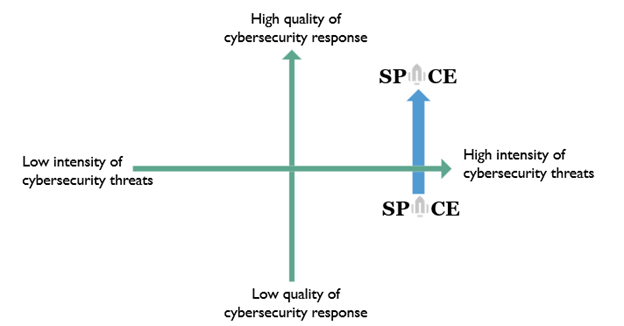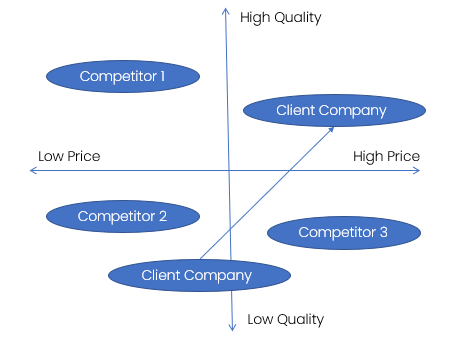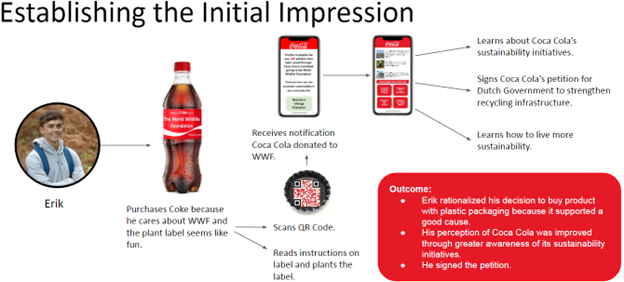Episode 10/11: Little Used Powerful Case Solving Tools
August 21, 2024
There are a variety of tools that can be utilised to construct an analysis for case-solving. In a previous newsletter, I addressed my insights on effectively employing the widely used SWOT tool and highlighted how many case-solving teams overlook its potential. I am certain that a few other potent tools are underutilised for analysing the organisation's environment in a case.
Competitive Landscape Maps
The first tool is the competitive landscape map. Below is the first example from one of my past case teams.
Competitive Landscape Map: Movement of a Company
In this example, the team is illustrating the changing competitive position of the organisation based on the recommended solution. It can also be used to show how the organisation compares to its competitors or a combination of both, as seen in the next example.
Competitive Landscape Map: The Competitors in the Environment and Movement of a Company
The power of this tool comes from its visual representation, which easily demonstrates the understanding of the competitive landscape to the judges. Its limitation is that it only shows two characteristics of the environment, so it can be simplistic in nature. However, if used properly, these characteristics can often be seen as the most important and can be linked to the decision criteria being used.
As emphasised in previous newsletters, linking the map to the broader analysis and exploring the connections is crucial for maximising its impact. Throughout my two decades of coaching, I've consistently witnessed how the competitive landscape map has empowered my teams to achieve success. However, it's vital to not simply showcase familiarity with the tool but to leverage it for constructing and intertwining the analysis with the ultimate solution.
Core Competencies
The second essential tool being underutilised is core competencies. While not conventionally perceived as a tool, core competencies showcase an in-depth understanding of an organisation's core competencies, enhancing credibility with judges. This demonstrates a profound understanding of the organisation as a whole.
Absolutely, here is the revised text with a more compelling and persuasive tone: Core competencies are the bedrock of an organisation, defining what it excels at and what is crucial for successful strategy implementation. Much like a map of the competitive landscape, core competencies serve as pivotal linkages tied to decision criteria, amplifying the impact of the chosen solutions while fortifying the overall strategic narrative.
In my view, core competencies are not just valuable in shaping the solution, but they are indispensable in ensuring a comprehensive implementation plan. Every step in the plan should serve to bolster the organisation's core strengths. The resources employed or sought after must align closely with the organisation's areas of excellence and areas needing improvement, directly shaping the path for successful strategy execution. These core competencies influence critical factors such as human resource requirements, strategic decisions on outsourcing or insourcing, and pivotal choices like mergers and acquisitions. Ideally, the plan should solidify core competencies while effectively addressing how to acquire the skills and capabilities the organisation currently lacks.
Wrap-up
Teams that have skillfully incorporated these tools have consistently outperformed others in competitions. This is because it demonstrates a deeper comprehension of the organisation and its environment, resulting in stronger connections with the judges. I wholeheartedly urge more case-solving teams to harness the power of these tools. In two weeks, I will unveil a couple of additional tools that are vital for success.
September 4, 2024
Today, I want to discuss three analysis tools that are often underutilised or misused in case presentations. The first tool is stakeholder analysis, and the second involves using personas and journey maps.
Stakeholder Analysis
Stakeholder analysis is frequently overlooked. It is typically only used to identify the stakeholders involved, but it should also be used to understand their concerns, needs, and power dynamics. Instead of simply identifying all stakeholders involved, the idea is to identify the most important stakeholders and discuss how they impact the situation. Understanding their needs, concerns, and how they fit into the stakeholder matrix is crucial for a successful solution.
One of Several Versions of a Stakeholder Analysis Matrix
The team should revisit the stakeholders during the wrap-up to demonstrate how the solution impacts their needs and concerns. The steps needed to satisfy stakeholder needs and concerns must be included in the implementation plan.
Personas
Another underutilised tool is personas. Teams often only look at a single persona, but it's important to consider multiple personas to understand the potentially multiple target groups of the solution. A persona is a realistic user profile that describes the needs, preferences, interests, and demographics of the user. What is the value of a persona?
- It helps everyone understand the target group
- It helps personalise experiences for the target group
- It helps identify the lifestyle characteristics and emotional needs of the target group, and
- It can help leverage data-driven offerings for the target group.
The three key aspects it identifies are motivations, goals, and pain points the target group experiences. A persona can then be used to create a journey map that details the steps of how the persona and organisation interact. Below is an example of a couple of simple personas from one of my former case teams.
Examples of Personas
Journey Maps
A journey map illustrates each step of the expected experience of the persona and the people who fall into the persona group. It helps to identify the pain points, problems, and issues, and predict the support needed to drive desired outcomes. This is accomplished through a detailed analysis of the touchpoints of a customer journey map. Below is an example of a customer journey for one of the personas above from a former case team of mine.
An Example of a Journey Map






No Comments